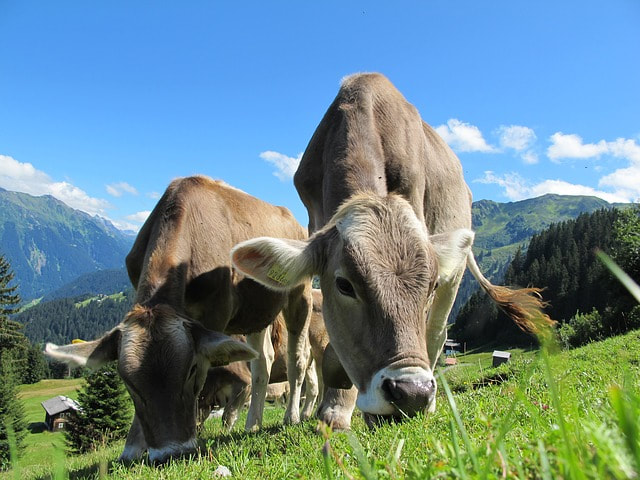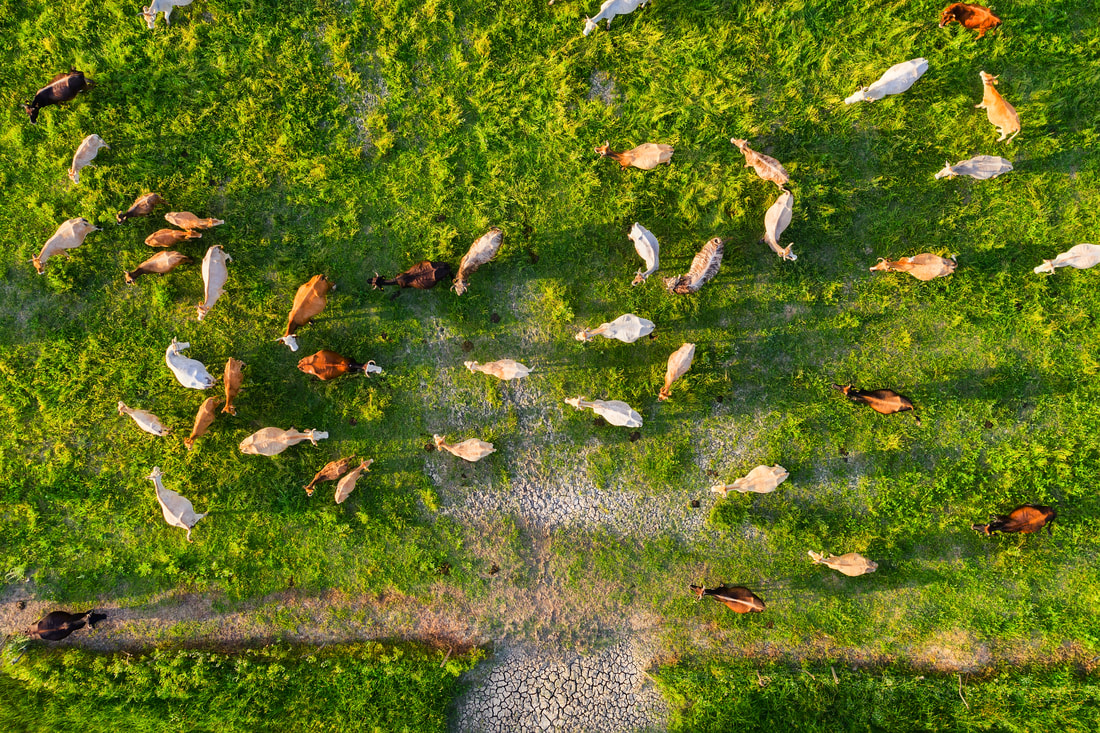Which cow for which environment?
Future-proofing European cattle production: GenTORE results and their potential impact
The issues:
European cattle production with dairy, beef and dual-purpose breeds is ubiquitous across a wide-range of geographical-climatic regions, employing a diversity of farm systems. Furthermore, the food industry asks for a diversity of products for different markets, often with added values, such as beef from pasture or hay milk. In contrast, breeding companies generally apply ‘one-size-fits all’ breeding goals within any given breed and country. This context, to which we must add the changes in future environmental conditions that are created by climate change, is an important issue for cattle producers: Which type of cattle is best for my production system in my current and future environment? From a breeder’s perspective this can be rephrased as: Which genotype of cattle is best for the current environment and likely future environments, and also has sufficient resilience to cope with possible current and future disturbances? This can be approached by considering what is the optimal blend of animal resilience and animal efficiency, when aiming for a more sustainable production. However, traits associated with resilience and even efficiency are poorly defined and difficult to measure. Further, it has until now not been easy to assess local production environments in terms of their importance for efficiency and their demands on animal resilience.
GenTORE contribution to solutions:
With respect to assessing local production environments, GenTORE has developed a combined regional topographic-climatic-farm type database for European cattle systems that has been made publicly available. This has been used to forecast the likely impacts of climate change on cattle production systems according to region. It has also been used to explore the key factors influencing economic efficiency. As such, it provides a basis for quantifying the resilience needs and efficiency possibilities for different local production environments.
European cattle production with dairy, beef and dual-purpose breeds is ubiquitous across a wide-range of geographical-climatic regions, employing a diversity of farm systems. Furthermore, the food industry asks for a diversity of products for different markets, often with added values, such as beef from pasture or hay milk. In contrast, breeding companies generally apply ‘one-size-fits all’ breeding goals within any given breed and country. This context, to which we must add the changes in future environmental conditions that are created by climate change, is an important issue for cattle producers: Which type of cattle is best for my production system in my current and future environment? From a breeder’s perspective this can be rephrased as: Which genotype of cattle is best for the current environment and likely future environments, and also has sufficient resilience to cope with possible current and future disturbances? This can be approached by considering what is the optimal blend of animal resilience and animal efficiency, when aiming for a more sustainable production. However, traits associated with resilience and even efficiency are poorly defined and difficult to measure. Further, it has until now not been easy to assess local production environments in terms of their importance for efficiency and their demands on animal resilience.
GenTORE contribution to solutions:
With respect to assessing local production environments, GenTORE has developed a combined regional topographic-climatic-farm type database for European cattle systems that has been made publicly available. This has been used to forecast the likely impacts of climate change on cattle production systems according to region. It has also been used to explore the key factors influencing economic efficiency. As such, it provides a basis for quantifying the resilience needs and efficiency possibilities for different local production environments.
Within GenTORE we have developed methods for improved description of resilience and efficiency at animal and farm levels. We have shown how resilience phenotypes can be derived by combining simple performance measures especially when frequent measures are available (e.g. daily deviation in milk yield from an expected milk curve). Frequent measures are also the key to having improved efficiency phenotypes (see Improved phenotyping of R & E document). Tools for genomic evaluation have also been developed, in order to increase the speed of genetic change. Systematic crossbreeding is important in beef herds, but also of increasing interest in dairy herds. Genomic breeding vaues for crossbred or admixed animals are difficult to predict with traditional genomic prediction methods focussing on purebreds, because the genetic-make up of crossbred animals is likely to be different from purebreds. To fill this gap, genomic evaluation methods specifically for multi-breeds, crossbreds or admixed individuals have been developed in GenTORE. The methods take into account the breed origin of each allele (BOA) in the population of interest. We have proposed multi-breed genomic models incorporating BOA that can accommodate reference populations of both purebred and crossbred animals for simultaneous prediction of purebred and crossbred selection candidates. In addition, GenTORE has developed methods to improve the quantification of genotype by environment interactions. This has been done within genomic evaluation models considering variation in GxE effects along the genome and also using systems biology models. We have developed an analysis protocol for genomic GxE models in which SNP effects may be different across the environments. The protocol consists of readily available BLUP software packages, which allows for easy and quick uptake by genetic evaluation centers (see Genomic Management Tools document).
The two strands phenotyping and genomic evaluation are combined in the simulationmodels of GenTORE. At the animal level, prediction models of lifetime performance have been developed for dairy and beef. These models are built on principles of resource allocation. The models built in GenTORE include trade-offs between productive functions and resilience under different environmental conditions. These models thus allow a better comprehension of the interrelations between production efficiency and resilience. At the population or breed level, it is possible to include resilience indicator traits investigated in GenTORE in the breeding goal of dairy cattle, yet with a cost on genetic gain achieved on milk production. This cost can be seen as an insurance premium that will be paid back if the environment becomes less favourable in future by having selected cows that can cope better with environmental perturbations. In addition, the resource allocation predictive models were used in synergy with simulation models of breeding schemes to explore the consequences of selecting for production efficiency under different prospective environments. Using this novel framework, it was shown that some breeding goals could lead to cows being more robust to changes in the nutritional environment, if these breeding goals limited the emergence of trade-offs between production and functional traits. Therefore, to ensure that genetic improvement will benefit a large panel of production environments and systems, it is critical to consider these trade-offs and their impact on resilience when defining breeding strategies for sustainable feed efficiency in dairy cattle.
This work at animal level has been extended to predict the impact of different breeding goals, including resilience traits or not, on milk yield, reproduction, longevity and greenhouse gas emissions (see Breeding Strategies for Mitigation document). These simulations have been done both for an environment without disturbances and for an environment with climate-change related disturbances such as drought and heat waves. Further, environmental and social life cycle assessments together with an economic assessment have been carried out on contrasted examples to assess the sustainability of different milk and meat production systems. Food-feed competition and economic robustness of farms have been added to this life cycle sustainability assessment. Broad sustainability assessments with the developed framework, which reveals strengths and weaknesses of production systems and conflicting goals, can be used as a base for decisions leading to improved sustainability of milk and meat production.
Applications and potential impact:
The results and tools described above are designed to allow the different actors in cattle production; farmer, advisor, breeder, to be able to:
- Broadly assess the extent to which any given local production environment is likely to be challenging to the animals reared in that environment. Currently, this is in the form of publicly available databases that could be the basis of an application that could be queried by advisors.
- Characterize cattle in terms of their resilience and production efficiency. Currently, this is in the form of methodologies applied to research data, primarily used to provide improved resilience and efficiency phenotypes for genomic evaluation. For applicability in the context of tailoring cattle to different environment, these methodologies would need to be incorporated into the ranking tools described below.
- For farmers, rank their cattle in terms of their predicted future worth. These tools have been deployed for use by farmers in Ireland, and are being adapted for similar use in the French context.
- For advisors and breeders, explore the predicted short- and long-term consequences of particular breeding strategies in different environments. Currently, this is in the form of research models that could form the basis of an application that could be queried by advisors.
The uptake of the above-mentioned ranking tools in Ireland, where several thousand farms use the cow culling index and the calf transaction index, has provided invaluable information to support value-creating decision-making. This demonstrates the potential impact of the work carried out in GenTORE on matching the right animals to their environments. In this one example it was possible to advance rapidly towards full applicability within the project lifetime. The other elements, that can be considered as building blocks for application, are part of the GenTORE legacy that should be further developed towards application after the end of the project.




